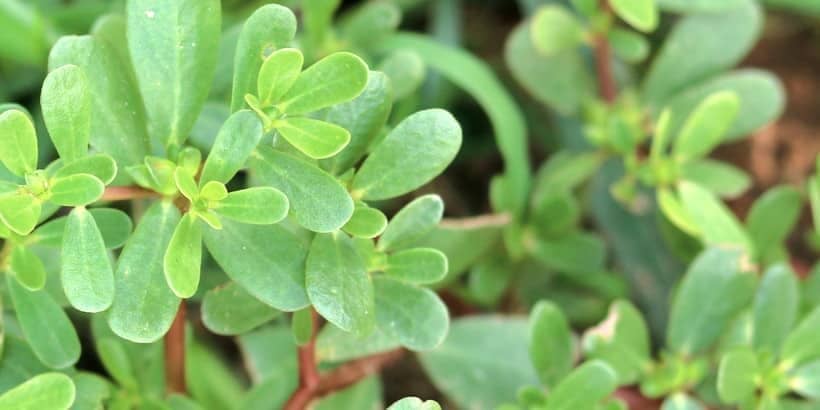The Promise of Purslane & Salt-Pickled Recipe

Are you quick to grab a shovel at the mere mention of purslane for fear it will overrun your garden? If you nodded your head “yes,” might we suggest taking a second to rethink your attack? This semi-succulent annual not only boasts the highest-yet-measured levels of omega-3 fatty acids (hello, health benefits!) in a plant; it also happens to be an excellent ingredient in many summer dishes.
Still not sold? Try your hand at this Salt-Pickled Purslane Leaves recipe, and we’ll bet you’ll change your mind!
The following excerpt is from Forage, Harvest, Feast by Marie Viljoen. It has been adapted for the web.
Purslane
Other common names: Portulaca, pigweed
Botanical name: Portulaca oleracea
Status: Annual weed
Where: Widespread on disturbed ground, in agricultural fields, and gardens
Season: Summer
Use: Vegetable
Parts used: Tender stems, leaves, buds, and green seed capsules
Grow? Yes
Tastes like: Succulent baby spinach, with some sourness
Most gardeners and farmers attack purslane when it infiltrates their domain. This is a shame.
The sprawling semi-succulent annual boasts the highest-yet-measured levels of omega-3 fatty acids in a plant. In my vegetable garden I transplant opportunistic purslane volunteers into tidy rows. I also grow ‘Golden’ purslane from seed. I know. Nuts.
Native Americans knew about purslane and used it fresh and cooked. On the other side of the Atlantic, Romans devoured it, BCE. It remains a well-known vegetable around the Mediterranean. And other North Americans are well informed: verdolagas (Spanish for “purslane”) are appreciated in Mexico, and routinely eaten.
The common purslane we know as a weed has uncertain origins. Asia? North Africa? And while it is thought to be a post-Columbian immigrant to North America, archaeological records have shown evidence of purslane seeds and pollen here as far back as 750 CE.

There are many ways purslane can be enjoyed, cooked, but boiling it is not on my list. Generally speaking, it is at its most appealing raw, with a crisp texture and faint sourness. These attributes work well with softer ingredients like ripe peaches, creamy mozzarella, and even roasted bone marrow (as a relish purslane assuages guilt and cuts the fat). Processed until smooth it lends a fullness to raw soups and green sauces. It is an edible tonic.
As with some other vegetables (Japanese knotweed, sheep sorrel), purslane’s vivid color fades with heat, and it also turns slightly mucilaginous. In Cape Town, porseleinbredie was a traditional Cape Malay dish, a slow stew made with lamb and succulent purslane leaves. And C. Louis Leipoldt, a lauded South African poet and food writer (before there was such a thing), as well as a medical doctor and amateur botanist, liked his porseleinblaar stewed with butter and mace and pounded to a paste.
I think the Romans would relate.
How to Collect and Prepare Purslane

Purslane’s flavor can be variable, as I learned from wild foods author John Slattery, author of Southwest Foraging: “If you gather it in the morning it will have more malic acid, and therefore be tangy in taste,” he writes. “Gathered in the afternoon it will be sweeter . . . as the malic acid is transformed into glucose.” I like it tangy.
Increasingly, purslane is showing up at farmers markets in late summer. When my own crop becomes too leggy, that is where I find a fresh supply. It has often wilted by the time it is sold and I plunge it into a large bowl of cool water until it has revived, snacking on the leaf tips while I wait.
Salt-Pickled Purslane Leaves
Makes 1⁄2 cup (about 30 g) after wilting
A quick salt pickle yields tangy leaves that can be used immediately in endless variety. Scatter them on toasted sourdough and drizzle with olive oil, top them with a warm egg, toss them with cold udon, dress them with toasted sesame oil and Prickly Ash Paste, add them to an omelet.
 Ingredients
Ingredients
1 cup (40 g) purslane leaves
1 tablespoon salt
1 teaspoon red chile flakes
Procedure
- Place the purslane in a small bowl with the salt.
- Massage it into the leaves.
- Add the chile and toss. Let sit for 45 minutes.
- Add water to the bowl, swoosh the leaves around, and drain.
- Turn them out onto a clean kitchen towel and roll into a sausage to dry.
- Unroll and fluff them up.
- They are ready.
Recommended Reads
Recent Articles
The Garlic Clove! This small crop adds a big punch of flavor that complements almost every delicious dish you could think of. And the best part? These two recipes are a breeze to make together!
Read MoreOur love affair with amaranth began long before the pseudo-grain became a trendy staple for gluten-free folk. The luscious leaves of this annual plant are not only packed with a plethora of health benefits.
Read MoreDon’t know where to start for foraging wild plants? Read on for the information you need to begin foraging on your own: where to do it and how to be safe.
Read MoreEasy rainbow coleslaw! Transform your salad game with this colorful recipe. It is surprisingly packed with flavor and is a great addition to your repertoire.
Read MoreIf you love tomatoes, you probably already know just how many varieties of these summertime staples there are. But do you know what makes each one unique?
Read More

 Ingredients
Ingredients







